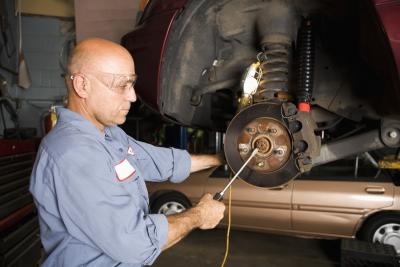
Signs of impending CV joint failure include clunking sounds coming from the wheels upon acceleration or deceleration and clicking noises when turning. Inspect the CV joint boot covers by raising your vehicle on a set of car ramps or by using a floor jack and jack stands. If the boots are torn, corroded, cracked or show any other signs of degradation, then the lubricant from the CV joint has most likely leaked out and has been replaced with dirt, grime and other contaminants. It's important to note that there are a variety of CV joint designs for different vehicles.
Raise the vehicle using a floor jack placed underneath the center of the engine and a set of jack stands placed on either side of the front doors. Check to make sure all four legs of the jack stands are resting securely on the ground. Remove the lug nuts from the tires with your vehicle's tire iron.
Use a torque wrench to remove the caliper mounting bolts from the rotor assembly. Use a wire coat hanger to suspend the caliper assembly from the coil springs in the wheel well.
Insert a pry bar between the wheel's lug nut studs and the ground to prevent the wheel from rotating while removing the hub nut. Use a torque wrench, or a spindle-nut socket, if appropriate for your vehicle, to remove the hub nut from the wheel hub. Remove the rotor assembly from the hub.
Remove the cotter pin from the wheel hub-steering knuckle assembly. Use a tie-rod-end puller to swing the steering knuckle away from the drive axle.
Pry and pull the CV joint shaft out from its housing. Some vehicles may have inner and outer CV joints that need to be removed separately. Other vehicles may require removing the driver's side CV joints prior to servicing the passenger side.
Snap the new CV joint into place, listening and feeling for a click, indicating that it's correctly positioned. Reinstall the steering knuckle and ball joint using a new cotter pin. Tighten the hub nut with a torque wrench set to the specifications indicated by your vehicle's manufacturer or service manual. Reinstall the caliper and tires. Lower your vehicle.